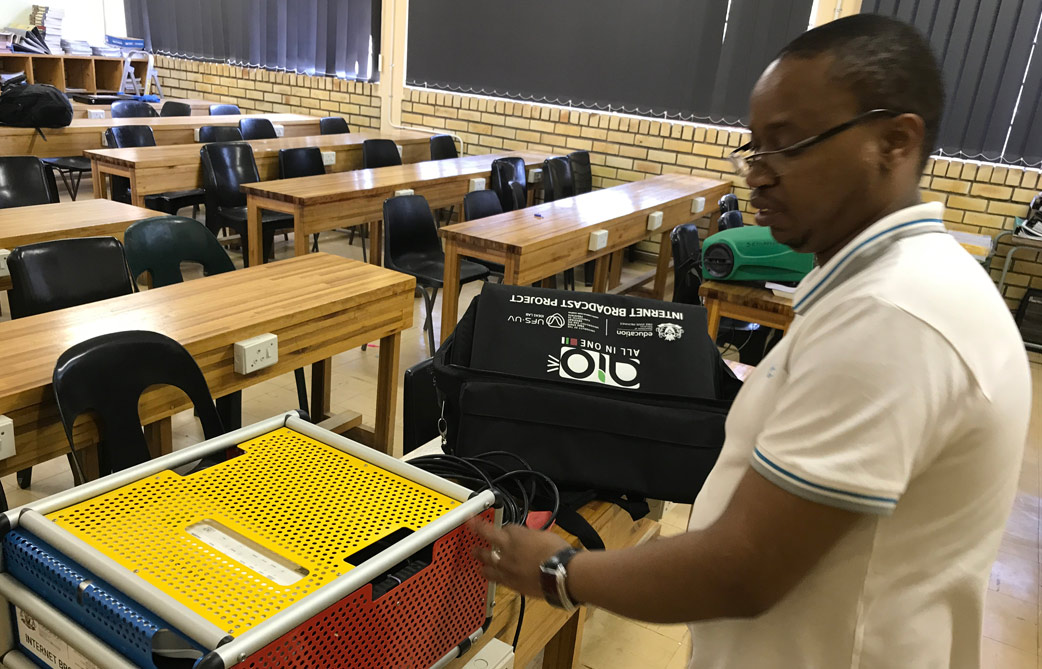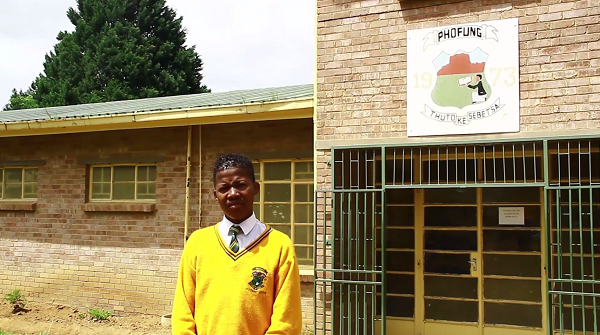
A student watches a lecture online via Mediasite.
Technology Across Borders
By Gary Weis
Imagine what would happen if there were no barriers to learning – if everyone who wanted to receive an education could do so regardless of their location, time (or lack thereof), or financial circumstances.
One of the reasons I believe online learning is so successful is because it is powerful enough to bridge time and distance, allowing schools to cross borders and educate students all over the world.
Geographical barriers can prevent students from attending classes, and those in bandwidth-challenged areas aren’t able to reliably receive live online learning content. The valuable ability to time shift becomes even more important in the face of unexpected events, such as epidemics, hurricanes, and wildfires. In situations like these, I’m seeing K-12 schools, colleges, and universities turn to unique video solutions to ensure learning isn’t disrupted.
What’s so exciting to me is that schools are finding creative ways to reach students all over the world, removing barriers to student success and creating graduates who otherwise would never earn a diploma. The following stories are some of my favorites that I’ve seen throughout my years working in education.
Flexibility in the Midst of Epidemics and Natural Disasters
Time shifting the learning process is not new.
During the hurricanes that ravaged the Caribbean and southern United States last fall, I saw faculty using online video to record lectures, allowing students to watch from home.
When a tornado touched down near The University of Oklahoma Health Sciences Center in Oklahoma City, lectures continued as planned online thanks to video, and no one missed a beat.
When wildfires forced California State University (CSU) Fullerton Department of Nursing and CSU San Marcos to cancel classes, both schools continued delivering instruction by capturing and streaming lectures online. Marsha Orr, distance education faculty liaison in the Department of Nursing, told me they didn’t want students to have to make a choice between potentially having to evacuate and coming to class.
“Because we are able to swiftly and easily capture the class and post it immediately to the web, it meant that the students didn’t lose any content. It meant not rescheduling. It meant not trying to double up on information,” she said.
Similarly, universities and healthcare organizations were in crisis mode last year during the Zika Virus outbreak. Schools turned to online video to deliver safety and preventative tips to the masses.
No-Boundaries Learning
Online learning is not only keeping classrooms running in times of trial, it is also democratizing learning around the world.
Internet Broadcast Project for Rural South Africa
In some South African provinces, 80 percent of schools are classified as failing due to a lack of quality teachers and severe home conditions in rural bandwidth-challenged areas. The University of the Free State’s IDEAS Lab in the Distance Education Department is looking to change that by providing support in core subjects to more than 80 schools – more than 54,000 learners and 3,000 teachers – within the Free State province.

Equipment for the Internet Broadcast project at the University of the Free State in South Africa is installed in a classroom.

Luckey Hlatshwayo poses outside of his school in rural South Africa. He became number one in his class after using video lectures to study.
The IDEAS Lab uses a private network to deliver five hours of daily video lectures from highly qualified teachers around the province. Videos are created in the IDEAS Lab studio and automatically distributed to remote endpoints via a robust MPLS VSAT content delivery network. The videos provide support for subjects like math, science, economics, accounting, and geography, as well as teaching development training programs.
Since the school began this program in 2011, the majority of school sites have shown improvement in pass rates, with some schools jumping from 17 percent to more than 96 percent.
One of the IDEAS Lab’s students is Luckey Hlatshwayo. He lives in one of the most rural areas of the South African Free State province. His family couldn’t afford to send him to a university, but Luckey, extremely motivated to succeed, put everything he had into his studies at Phofung Secondary School. He became number one in his class after using video lectures to study. Now, he wants to go to a university to study actuarial sciences.
“I see the light for me,” he said in a video the University of the Free State created about its video lecture program. “If you can’t change the situation, make the best of it. I made the best of it. You can do better by hard work. Your books are there. We have teachers. We have so many things. You just have to use them and work hard.”
Michigan Virtual University and Nigeria
In Nigeria, 1.2 million students qualify to begin college each year, but the country’s 104 universities can only accept 300,000 students. Infrastructure challenges in the country, such as unstable electricity, bandwidth problems, and poor roads, also pose challenges for many. In response to the great demand for distance learning to make in-country education more accessible, Michigan Virtual University is supporting Nigeria’s first e-learning project.
Using video technology and a mobile device, e-learning students at the Center for Distance Learning at Obafemi Awolowo University participate in lectures from anywhere. The university predicts more than 50,000 people per year will receive undergraduate and post-graduate degrees through this program.
Florida State University and Global STEM Education
Florida State University emphasizes global responsibility for education. Its desire to foster creativity and provide a free resource for educational material with the skills and talents of people around the world led to the creation of Global Educational Outreach for Science Engineering and Technology (GEOSET), a global network of participating sites that deliver exceptional downloadable STEM teaching materials created by the best science and technology experts and educators.
Goethe University and Indonesia
At Frankfurt, Germany’s Goethe University, graduate student Maya Tutughamiarso taught an online high school chemistry class. She originally had difficulty connecting with her students, but not in the typical teenager versus adult way — they were on separate continents. She taught the online class from Frankfurt, while the students were in Indonesia.
Students aren’t just learning in classrooms face-to-face with their instructors anymore. Connecting virtually is allowing students, regardless of time and distance, to receive a high-quality education when and where it’s convenient. Having an academic video strategy means students will never miss a beat in the face of unexpected circumstances.
